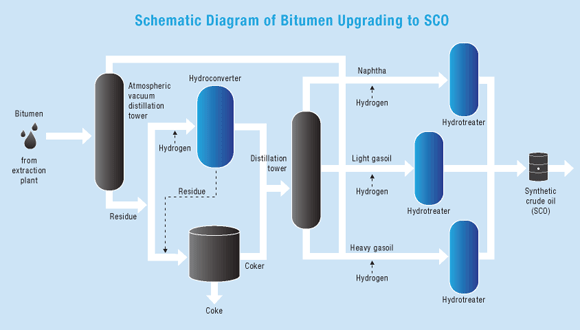Upgrading and Refining Process Development
In the figure below, you can see a schematic diagram example of the upgrading process pathway for cleaned bitumen in order to transform it into value-added synthetic crude oil (SCO). Bitumen processed through this stage has already undergone separation from water and particulate matter (mainly sand and clay) in the extraction plant before entering into the primary upgraders.
As an example of upgrading process development, research scientists are currently developing a novel monolithic hydrotreating technology for middle distillates that has the potential for at least a 2- to 3- fold increase in process efficiency compared to conventional hydrotreating processes. Furthermore, it intensifies the hydrotreating processes to the extent that it will reduce the need for new hydrotreating capacity in bitumen and extra-heavy oil upgraders by ~50%.
Managed by CanmetENERGY at the Devon (Alberta) research centre.

Text version
Diagram of bitumen upgrading to synthetic crude oil (SCO)
- Bitumen from the extraction plant enters the upgrading facility.
- Bitumen is first sent to an atmospheric distillation tower. The resulting products are naphtha, light gas oil, heavy gas oil and residue.
- Each of the naphtha, light gas oil and heavy gas oil streams is then sent to its own separate hydrotreater to remove sulphur and nitrogen by adding hydrogen. The resulting products from each of the separate hydrotreaters are then combined to produce synthetic crude oil.
- The residue stream from the atmospheric distillation tower is further separated into two streams, heavy vacuum gas oil and vacuum residue. The heavy vacuum gas oil is mixed with the heavy gas oil from the atmospheric distillation tower to undergo hydrotreating. The vacuum residue is further upgraded either in a hydroconverter by adding hydrogen or in a coker to produce lighter liquid product and by-product coke (in the coker).
- The lighter liquid product from the hydroconverter or coker is further separated into naphtha, light gas oil and heavy gas oil by distillation. Each of these three streams are mixed with the corresponding liquid product from the atmospheric distillation tower and then sent to the separate hydrotreaters to remove sulphur and nitrogen by adding hydrogen.
- The final products from the upgrading facility are SCO and coke.
Page details
- Date modified: